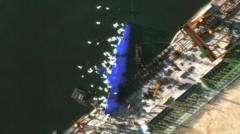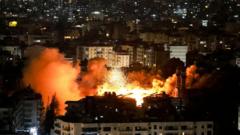North Korea's leadership addresses a recent warship mishap, utilizing manual processes to restore the vessel while tightening political control among military officials.
North Korea's Warship Refloated Following Failed Launch Incident

North Korea's Warship Refloated Following Failed Launch Incident
Efforts to restore the 5,000-tonne destroyer gain momentum amidst internal scrutiny and military aspirations.
North Korea has successfully refloated a warship approximately two weeks after it capsized during a launch attempt, an event that faced significant criticism from the nation’s leader, Kim Jong Un. State media outlet KCNA announced on Friday that the destroyer had "safely entered the water vertically" and is now secured at a pier. The vessel is anticipated to undergo full repairs in time for an important meeting led by Kim, with high-ranking officials from the ruling party in attendance.
The 5,000-tonne destroyer was seen upright at the pier, and subsequent satellite imagery revealed it "floating in the harbour" shortly afterward, according to analyses from news agencies 38 North and NK News. The operation to stabilize the ship, conducted on Thursday, relied on manual tactics, with workers using tethers and barrage balloons to bring the vessel back to an upright position, some of which remained attached to the ship after it was refloated.
Kim Jong Un, who directly observed the destroyer topple during its launch attempt, labeled the incident a "criminal act" that "severely damaged the [country's] dignity and pride". He attributed the disaster to factors including "absolute carelessness, irresponsibility, and unscientific empiricism." Following the botched launch, at least four officials, including Ri Hyong-son of the Workers' Party's Munitions Industry Department, have reportedly been arrested, facing uncertain consequences in a regime known for its severe punitive measures.
Analysts interpret Kim's harsh and prompt reaction to the failed launch as an indication that North Korea is steadfast in its goal to reinforce its military capabilities. The regime has been keen on projecting an image as an ascending military power, suggesting that such setbacks may only fuel their determination to progress. Kim’s stringent response is viewed as a strategy to bolster his authority and maintain the regime’s focus on military advancements, especially following the recent unveiling of a similar warship, which Kim hailed as a major development in modernizing North Korea's navy and slated for deployment next year.
The 5,000-tonne destroyer was seen upright at the pier, and subsequent satellite imagery revealed it "floating in the harbour" shortly afterward, according to analyses from news agencies 38 North and NK News. The operation to stabilize the ship, conducted on Thursday, relied on manual tactics, with workers using tethers and barrage balloons to bring the vessel back to an upright position, some of which remained attached to the ship after it was refloated.
Kim Jong Un, who directly observed the destroyer topple during its launch attempt, labeled the incident a "criminal act" that "severely damaged the [country's] dignity and pride". He attributed the disaster to factors including "absolute carelessness, irresponsibility, and unscientific empiricism." Following the botched launch, at least four officials, including Ri Hyong-son of the Workers' Party's Munitions Industry Department, have reportedly been arrested, facing uncertain consequences in a regime known for its severe punitive measures.
Analysts interpret Kim's harsh and prompt reaction to the failed launch as an indication that North Korea is steadfast in its goal to reinforce its military capabilities. The regime has been keen on projecting an image as an ascending military power, suggesting that such setbacks may only fuel their determination to progress. Kim’s stringent response is viewed as a strategy to bolster his authority and maintain the regime’s focus on military advancements, especially following the recent unveiling of a similar warship, which Kim hailed as a major development in modernizing North Korea's navy and slated for deployment next year.





















